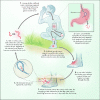Dracunculiasis (guinea worm disease)
- PMID: 14970098
- PMCID: PMC332717
Dracunculiasis (guinea worm disease)
Abstract
Dracunculiasis (guinea worm disease) is a parasitic disease that is limited to remote, rural villages in 13 sub-Saharan African countries that do not have access to safe drinking water. It is one the next diseases targeted for eradication by the World Health Organization. Guinea worm disease is transmitted by drinking water containing copepods (water fleas) that are infected with Dracunculiasis medinensis larvae. One year after human ingestion of infected water a female adult worm emerges, typically from a lower extremity, producing painful ulcers that can impair mobility for up to several weeks. This disease occurs annually when agricultural activities are at their peak. Large proportions of economically productive individuals of a village are usually affected simultaneously, resulting in decreased agricultural productivity and economic hardship. Eradication of guinea worm disease depends on prevention, as there is no effective treatment or vaccine. Since 1986, there has been a 98% reduction in guinea worm disease worldwide, achieved primarily through community-based programs. These programs have educated local populations on how to filter drinking water to remove the parasite and how to prevent those with ulcers from infecting drinking-water sources. Complete eradication will require sustained high-level political, financial and community support.
Figures






Similar articles
-
Eradication of dracunculiasis from Pakistan.Lancet. 1995 Sep 2;346(8975):621-4. doi: 10.1016/s0140-6736(95)91442-0. Lancet. 1995. PMID: 7651010
-
Towards global Guinea worm eradication in 2015: the experience of South Sudan.Int J Infect Dis. 2013 Aug;17(8):e577-82. doi: 10.1016/j.ijid.2013.03.003. Epub 2013 Apr 24. Int J Infect Dis. 2013. PMID: 23623648 Review.
-
Update: dracunculiasis eradication--Ghana and Nigeria, 1990.MMWR Morb Mortal Wkly Rep. 1991 Apr 19;40(15):245-7. MMWR Morb Mortal Wkly Rep. 1991. PMID: 1826338
-
Progress toward global eradication of dracunculiasis--January 2011-June 2012.MMWR Morb Mortal Wkly Rep. 2012 Oct 26;61(42):854-7. MMWR Morb Mortal Wkly Rep. 2012. PMID: 23095954
-
Dracunculiasis eradication.Bull Soc Pathol Exot. 2006 Dec;99(5):377-85. Bull Soc Pathol Exot. 2006. PMID: 17253057 Review.
Cited by
-
A Multiscale Model for the World's First Parasitic Disease Targeted for Eradication: Guinea Worm Disease.Comput Math Methods Med. 2017;2017:1473287. doi: 10.1155/2017/1473287. Epub 2017 Jul 20. Comput Math Methods Med. 2017. PMID: 28808479 Free PMC article.
-
A One Health Approach for Guinea Worm Disease Control: Scope and Opportunities.Trop Med Infect Dis. 2020 Oct 13;5(4):159. doi: 10.3390/tropicalmed5040159. Trop Med Infect Dis. 2020. PMID: 33066254 Free PMC article. Review.
-
Dracunculiasis--the saddle is virtually ended.Parasitol Res. 2008 Feb;102(3):343-7. doi: 10.1007/s00436-007-0828-9. Epub 2007 Dec 12. Parasitol Res. 2008. PMID: 18074151 Review.
-
Dermatology on the global stage: The role of dermatologists in international health advocacy and COVID-19 research.Int J Womens Dermatol. 2021 Dec;7(5):653-659. doi: 10.1016/j.ijwd.2021.10.003. Epub 2021 Oct 23. Int J Womens Dermatol. 2021. PMID: 34722850 Free PMC article. Review.
-
Natural Products Are a Promising Source for Anthelmintic Drug Discovery.Biomolecules. 2021 Oct 4;11(10):1457. doi: 10.3390/biom11101457. Biomolecules. 2021. PMID: 34680090 Free PMC article. Review.
References
-
- Smith GS, Blum D, Huttley SRA, Okeke N, Kirkwood BR, Feachem RG. Disability from dracunculiasis: effect on mobility. Ann Trop Med Parasitol 1989;83(2):151-8. - PubMed
-
- Belcher DW, Wurapa FK, Ward WB, Lourie IM. Guinea worm in southern Ghana: its epidemiology and impact on agricultural productivity. Am J Trop Med Hyg 1975;24(2):243-9. - PubMed
-
- Watts SJ, Brieger WR, Yacoob M. Guinea worm: an in-depth study of what happens to mothers, families and communities. Soc Sci Med 1989;29(9):1043-9. - PubMed
Publication types
MeSH terms
LinkOut - more resources
Full Text Sources
